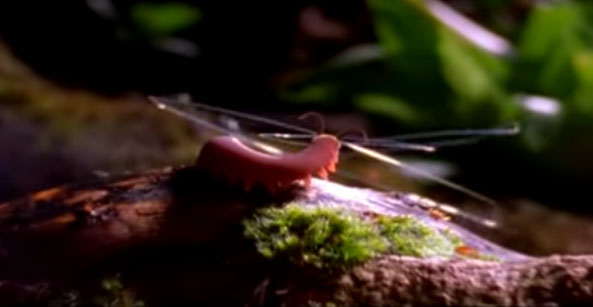What is Peripatus?

What Peripatus is, is unique.
At first glance, it looks like a caterpillar. However, on closer examination the external appearance is more like an annelid (earth) worm. In fact, it is also called a ‘velvet worm’. The head is continuous with the body. The eyes probably distinguish only light and dark. The outer cuticle is thin and flexible, with no external segmentation (divisions).
The internal anatomy is similar to the arthropods including, for example, lobsters, insects and spiders. And the appendages (‘legs’) are hollow, unjointed, cone-shaped structures with a retractable foot and hooked claw.
These organisms live only in moist habitats such as the tropical forest floor and in rotting logs. They are nocturnal and carnivorous, feeding on small live insects and crustaceans and carcasses of larger insects.
Their method of catching victims is certainly original. Two slime glands, at the side of the mouth, eject a milky fluid up to 30 centimetres which congeals on contact with air, entangling the prey. The flexible body allows these predators to pursue victims even into cracks and crevices.
The group known as Onychophora, which includes Peripatus and similar forms, contains 70 known species in two families. They need a lot of moisture in their environment, and range in size from 1.5 to 15 centimetres (5/8 of an inch to 6 inches).
Not a ‘missing link’
Many biologists, taking into account the mixture of characteristics — some typical of annelids and others of arthropods — consider the onychophorans to be transitional between these two major groups of animals. However, Stephen Jay Gould points out in Wonderful Life (W.W. Norton & Company, 1989, p. 168) that the appearance of arthropods, according to evolutionary timetables, should have occurred more than 550 million years ago. Gould does not believe that Peripatus could have lasted in its present form for so long.
There is an organism in the fossil record however, that is extraordinarily similar. It is Aysheaia from the Burgess Shale (dated at 530 million years old). The difference is that Aysheaia was apparently marine, whereas Peripatus and all living onychophorans are terrestrial. Nevertheless, Gould quotes G. Evelyn Hutchinson to the effect that in life, Aysheaia must have been extraordinarily similar to Peripatus (p. 169), and Gould himself says of Peripatus and Aysheaia, 'the similarities are impressive and anatomically deep, the differences superficial …’ (p. 171).
According to standard evolutionary interpretations then, organisms closely resembling Peripatus have existed for an extraordinary time interval. It seems most unlikely that an organism represented by such a restricted ecology should have survived so long. The more reasonable alternative is that Peripatus has lived only a short time on earth and that the long-age interpretations are incorrect.
Amazing Feature
There is another amazing feature of Peripatus and other onychophorans. Within this small group with almost no other variation, there is an astonishing range of reproductive strategies. The variety is as great as we find in the whole class Mammalia (mammals). This remarkable diversity of reproductive styles includes development like that of monotremes (such as the platypus, which lays eggs), marsupials (such as kangaroos, which protect tiny live-born young in a special pouch and nourish them on mother's milk) and placentals (the young are nourished in the uterus by means of a placenta and are then born live).
Within the one family of onychophorans (the Peripatidae) are individuals with a true placenta. These can be found around the world in the tropics. Others in this family do not have a true placenta, but instead develop a large yolky egg inside the mother. These animals can be found in the eastern Himalayas, Malay Peninsula, Sumatra and Borneo.
Females in the family Peripatopsidae, on the other hand, either lay eggs or retain the eggs inside the mother, where development is facilitated by secretions, but no true placenta is involved. These animals are southern in distribution, for example South America, South Africa and Australia.
What we know about Peripatus and other onychophorans is that this is a group with generalized feeding habits, which lives in warm, moist protected environments. It is supposed to have remained much the same for extremely long periods of time, except for a wide diversity of the most sophisticated reproduction styles. It seems unreasonable to accept that reproduction could become so varied while the rest of the organism stayed static and primitive for close to 600 million years.
Rather, these organisms demonstrate the richness and variety of creation. What Peripatus is, is wonderful.
(© Creation Science Dialogue, #194, 3803 Calgary Trail S., Suite 1136, Edmonton, Alberta, T6J 5M8, Canada. Used with permission.)










Readers’ comments
Comments are automatically closed 14 days after publication.